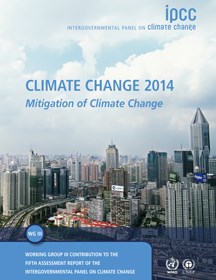
by Brianna Crandall — May 2, 2014—A new report released April 13 by the Intergovernmental Panel on Climate Change (IPCC) shows that global emissions of greenhouse gases have risen to unprecedented levels despite a growing number of policies and hard work at various levels to reduce energy use and climate change. According to a summary of the report from the U.S. Department of Energy’s Office of Energy Efficiency and Renewable Energy (EERE), emissions grew more quickly between 2000 and 2010 than in each of the three previous decades.
According to the report, which is the Working Group III contribution to the IPCC’s Fifth Assessment Report (AR5), it would be possible, using a wide array of technological measures and changes in behavior, to limit the increase in global mean temperature to two degrees Celsius above pre-industrial levels. However, only major institutional and technological change will give a better-than-even chance that global warming will not exceed this threshold.
Scenarios outlined in the report show that to have a likely chance of limiting the increase in global mean temperature to two degrees Celsius, mid-century global greenhouse gas emissions should be lowered by 40% to 70% compared with 2010, and to near zero by the end of this century.
The report, entitled Climate Change 2014: Mitigation of Climate Change, is the third of three Working Group reports, which, along with a Synthesis Report due in October 2014, constitute the IPCC’s Fifth Assessment Report (AR5) on climate change.
For the report, about 1,200 scenarios from scientific literature were analyzed. These scenarios were generated by 31 modeling teams around the world to explore the economic, technological, and institutional prerequisites and implications of mitigation pathways with different degrees of ambition. Cutting emissions from electricity production to near zero is a common feature of ambitious mitigation scenarios, but using energy more efficiently is also important, according to the EERE summary.
See also the statement released by the U.S. Department of Energy in response to the IPCC report.





